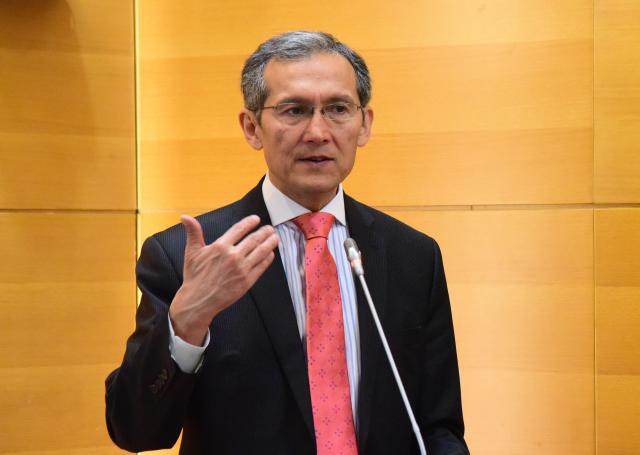吉尔吉斯共和国前总理、我院特聘教授卓奥马尔特·奥托尔巴耶夫 (Djoomart Otorbaev)日前在中国环球电视网 (CGTN) 上发表题为《如何在疫情后恢复国际贸易》的英文文章。他表示,新冠疫情将对世界经济造成影响,正确预测国际贸易的复苏对于重振世界经济十分重要。

图片为卓奥马尔特·奥托尔巴耶夫在京师一带一路大讲堂演讲的资料图片
吉尔吉斯共和国前总理、我院特聘教授卓奥马尔特·奥托尔巴耶夫 (Djoomart Otorbaev)4月19日在中国环球电视网 (CGTN) 上发表英文文章。他表示,新冠疫情将对世界经济造成影响,正确预测国际贸易的复苏对于重振世界经济十分重要。以下是经翻译后的中文版内容。

显而易见,目前这场新冠疫情将引发全球经济危机,对世界经济造成前所未有的影响。国际货币基金组织(IMF)总裁克里斯塔利娜-格奥尔基耶娃上周说:"在IMF的历史上,我们从未见过世界这般经济停滞不前。"就在三个月前,国际货币基金组织还曾预测今年全球经济将增长3.3%,而如今该预测被修订为萎缩3%。
经济衰退的深度和持续时间将取决于各国政府维持封锁状态的时间会有多长。许多人预计这种状态将持续到夏季。
经济合作与发展组织(OECD)估计,每封锁一个月,全年GDP增长就会损失2个百分点。国际货币基金组织模拟了几种情况,在最坏的情况下,全球经济将萎缩11%左右,而不是3%。
国际贸易无疑是拉动经济增长的因素。2018年,全球货物贸易值约为19.5万亿美元,比1980年增长了近10倍。这也带动了世界生产总值在同期增长了7.6倍。
世界贸易组织(WTO)4月8日表示,今年全球贸易将下降13%至32%。而在2009年金融危机最严重的时候,贸易下降了12.5%。
更为悲观的情况是,此次全球贸易的衰退如同90年前的大萧条时期,但持续时间会更短。"这些预测的情况很糟,但是无法避免。"世贸组织总干事罗伯托-阿泽维多在新闻发布会上说。他认为将其与上次的金融危机甚至上世纪30年代的大萧条进行比较是难免的。
不过,与之前危机不同的是,目前银行并不缺乏资金,经济引擎的状态也良好。WTO经济学家估计,如果疫情能较快得到控制,那么贸易和生产最早在2021年就有可能恢复回到到疫情前的发展轨迹。现在需要的是有远见的政策决定,以保持市场的开放性和确定性,保持企业和家庭对未来的信心。
全球经济状况的关键在于全球贸易结构将如何因疫情而改变。因此,正确预测国际贸易的复苏对于世界经济的尽快恢复是十分重要的。

2020年3月18日,纽约空荡荡的时代广场。/路透社
在过去几十年里,世界贸易并没有实现真正的国家间贸易,而是存在大量的公司内部的贸易。跟据不同的估计,35%至50%的跨国货物贸易实质属于公司内部的贸易。
从2010年代初期开始,国际贸易的增长速度开始放缓。随着中美之间的贸易摩擦加剧,各国和企业都开始意识到失去一个供应商可能对整个生产链都带来风险。
加深本土化,减少供应链中的不同司法管辖区的数量已成为了全球趋势。2019年的国际贸易额出现了一点下滑,而全球生产总值却增长了2.9%。
目前的情况是,一些国家的政府迅速将某些物品定义为"战略性",并禁止这些物品的出口,故意把完备的国际供应链破坏了。目前政府优先保障的是粮食安全或医疗供给等。
我们在过去一段时间里已经看到贸易限制和新设立的关税是如何破坏国际市场上小麦、面粉、药品、防护设备或呼吸机的生产和销售的。
当涉及到某些国家认定的国计民生的必需品时,我们很有可能将看到越来越多的贸易民族主义。有两个案例可以说明。
第一个是美国政府试图将3M公司在新加坡工厂生产的防护物品转为美国专属,尽管3M公司一直在为其他客户生产。
第二个是荷兰飞利浦公司在美国的一家生产通风机的工厂也受到了类似的压力,该公司的美国工厂被要求优先向美国客户供货。
贸易民族主义将通过区域集群的发展,使得国际贸易向新的、更成熟的阶段演进。鉴于全球价值链大幅缩短,欧盟、东盟、南方共同市场、上合组织等区域性组织将扮演其更为重要的作用。
虽然一些行业可能会从建立全面本土化供应链的"政治"企图中获得短期利益,但更多的行业将受损,也将进一步损害已经受到经济衰退冲击的消费者。经济复苏会更加困难。
长远来看,专业化分工和规模化生产的倒退将减低生产力和阻碍经济增长。世界的内部重组不可避免。疫情结束后,"主权下的全球化"会更加被重视,会更加强调本土的文化特点和本土化的解决方案。如果世界各国家继续转向封闭来应对这场危机,会给世界经济复苏带来更多的不确定性,也不会改善普通民众的生活。贸易和经济上的自我封闭不应成为我们生活的新常态。
(廖舟译)
卓奥玛尔特·奥托尔巴耶夫(Djoomart Otorbaev)4月19日在中国环球电视网(CGTN)发表的英文原文如下:
How to restore international trade after the pandemic ends
By Djoomart Otorbaev
Editor's note: Djoomart Otorbaev is the former prime minister of the Kyrgyz Republic, a distinguished professor of the Emerging Market Institue of Beijing Normal University, and a member of Nizami Ganjavi International Center. The article reflects the author's views, and not necessarily those of CGTN.
It is clear to everyone that the global crisis of the world economy caused by the pandemic will have unprecedented economic consequences. Managing Director of the International Monetary Fund (IMF) Kristalina Georgieva was quite emotional last week: "Never in the history of the IMF have we witnessed the world economy coming to a standstill," she said. Just three months ago, the IMF predicted global growth at 3.3 percent this year. Now it has replaced it with a contraction of 3 percent.
The depth and duration of the economic downturn will depend on how long governments maintain their lockdowns. Many expect the constraints to last into the summer.
The Organization for Economic Cooperation and Development (OECD) estimates that for each month of containment, there will be a loss of 2 percentage points in annual GDP growth. The IMF has modeled a few scenarios. In the worst case the global economy would shrink by around 11 percent rather than 3 percent.
International trade is the undoubted driving factor of economic growth. In 2018, the global trade value of goods throughout the world, which is referred to as the exchange of capital, goods and services between different countries, amounted to approximately 19.5 trillion U.S. dollars, which a nearly tenfold increase from 1980. It was one of the main reasons for the gross world product growth. Meanwhile, it was up 7.6 times.
On April 8 the World Trade Organization (WTO) stated that global trade would fall this year by between 13 percent and 32 percent. For comparison, at the height of the financial crisis in 2009, trade dropped 12.5 percent.
The more pessimistic case would amount to a decline in global trade similar to what happened in the great depression 90 years ago but in a shorter period. "These numbers are ugly and there is no way around that," WTO Director-General Roberto Azevedo told a press conference. Comparisons with the financial crisis and even the Great Depression of the 1930s were inevitable, he said.
However, unlike then, banks were not short of capital and the economic engine is in decent shape. WTO economists estimate that if the pandemic is brought under control relatively soon, trade and output could potentially rebound nearly to their pre-pandemic trajectory as early as 2021. Visionary policy decisions to keep the markets open and predictable, and confidence of businesses and households about the near future are now required.
The state of the global economy will critically depend on how the structure of global trade will be changed during the pandemic period. That is why a correct forecast of rehabilitation of international trade and its return to a predictable recovery is so important for the quickest restoration of the world economy.
World trade in the past few decades has developed not as a truly international, but rather as an internal corporate business. According to various estimates, from 35 to 50 percent of goods crossing national borders belonged to a particular corporation.
The growth rate of international trade began to decelerate from the beginning of the 2010s. As trade friction between the United States and China intensified, the countries and corporations began to realize the risks associated with the impact of the possible loss of one supplier on the entire production chain.
Deeper localization and the reduction in the number of jurisdictions in supply chain planning have become a global trend. In 2019 international trade volume even fell a bit while the global gross product grew by 2.9 percent.
What is happening now is that some governments are moving fast to deliberately disrupt well-established international supply chains by blocking their export of items considered to be "strategic." Priorities currently include, for example, food security or medical supplies.
These days we are seeing how trade restrictions and new tariffs destroying the international competition in production and distribution of wheat, flour, medicines, protective equipment or ventilators.
It is quite likely that we will see more and more trade nationalism when it comes to what individual governments regard as essential goods or resources required for the security of the population. Let's just have a look into two recent cases.
The U.S. government is trying to redirect 3M's production of safety equipment from its Singapore factory exclusively for the U.S., even though 3M has been producing equipment for other customers.
Similar pressure was exerted on a U.S. factory of the Dutch firm Philips Electronics, which produces ventilators, to prioritize a supply exclusively to U.S. customers over clients from other countries.
Trade nationalism will evolve toward a new, more established phase of international trade through the development of regional clusters. Given the gap or major decrease in global value chains, regional associations such as the European Union, ASEAN, Mercosur or Shanghai Cooperation Organization will play an important role.
While some favored industries might get short-term benefits from "political" attempts to create wholly national supply chains, many more would lose, and so would the consumers already hit by the recession. This would place a brake on the recovery.
In the longer term, the loss of specialization and scale would lower growth and productivity. The world's internal reorganization is inevitable. Closer attention to "sovereign globalization," aimed at our cultural characteristics and localized solutions will continue after the end of the epidemic. Responding to this crisis by turning further inward would add further uncertainty to the world's economic recovery and will not improve ordinary people's lives. Trade and economic self-isolation should not become the new normal in our lives.